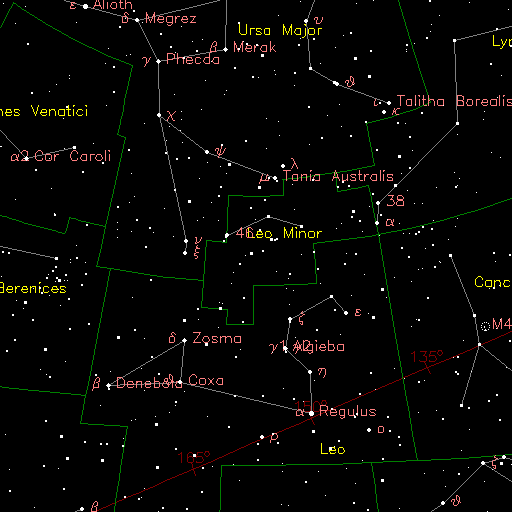Leo and its galactic and Universal connections

Leo is thought to be "royal", noble and loyal one - he's generous, fair, self-confident and with visionary wisdom. He's full of energy and passion, very creative and loves fun and pleasures.
In this sense a direct answer to what we have created in Cancer - in Leo we're learning to apply the "new being", to govern and navigate that "kingdom" of self...
Just as the majestic "cat", we also "roar" here at times...
Leo is a constellation, a bit easier to recognize in our night skies than others and is therefore a region of the heavens associated with many myth and tales around the globe.
What I find interesting to note, there are many galaxies observable in sidereal Leo and in the later part, also some supercluster of galaxies, firmly confirming the lion's intergalactic connectedness.
In the far south parts of "Argo Navis" and Hydra, just North of Leo there is Leo-minor and the other half of Ursa Major and part of Draco north of Ursa Major.
The lion's head
is expressing through late Cancer. Algenubi, the eye of the lion and Rasalas, the crown of the lion. The lion calls out to explore the "renewed" life and gives generously of his free thinking abilities. I think, the mane of the lion, in early sidereal Leo, can be looked at as like the "halo" and may talk about our own "radiation".
Interestingly, Ceres is travelling along the lion's head during her orbit and many other "minor planets" do station at one or another star of this "sickle asterism".
Regulus embodies the "essence" of Leo
In many ancient cultures Regulus was named (in their languages) as the "King or Prince", Law-Giver, King of the celestial spheres and of course "the lion's heart", suggesting themes like integrity, and to live true to the heart with noble confidence....
Regulus was seen as one of the 4 "royal stars" and "assigned" to Archangel Raphael.
Sextant constellation
south of the ecliptic (ca. 9 to 15 degrees sidereal Leo) is about orientation or positioning of self within the "grander scale" - also of re-evaluating energy.
Zosma: (delta Leonis)
means shoulder, hip or back - it can be associated with the story of Hercules breaking the back of the Nemean lion in Greek mythology - alignments with this star (depending which planetary body) can indicate experiences where we feel powerless or even crushed or broken, something that can be very painful, yet, can be turned into strength and lessons learned.
- I've seen this playing a role in progressed charts as well -
Denebola
the lion's tale at ca. 26 degrees sidereal Leo marks a longitude of the heaven very powerful - it's a region with strong creative power that "must" be released, hard to "hold back". Approaching the Leo-Virgo cusp, it marks an area where we need to gain clarity of the underlying currents or spiritual truth, seeing through mere "power plays" and facades within and on the stage of life...
Draco
is a big/long, circumpolar (never setting, to be seen all year long) constellation with many stars but not very bright stars in visible magnitude. The Star Thuban, in longitude "in Leo" was the Pole star thousands of years ago - today's pole star is Polaris in the constellation of Ursa Minor (Gemini part). It's important because of the precessional cross of in perspective of our All evolutionary path. For this reason Thuban talks about our ancestors - the wisdom and insight we can gain from our "family tales" as well as from history.
Interesting is - in January 2020 Nasa published a short paper and video about Thuban, as they have been able to observe an "anomaly" and did find out, that Thuban does experience eclipses.
Ursa Major - the great Bear
An old constellation - already mentioned in very ancient Egyptian Astronomy as well as all around the world in different asterisms but often referring to "north or nordic". It's as Draco a circumpolar constellation. It's known for it's primary seven stars forming the so called "little Dipper" (the Wagon). Two of its stars, named Dubhe and Merak (α Ursae Majoris and β Ursae Majoris), can be used as the navigational pointer towards the place of the current northern pole star, Polaris in Ursa Minor. - when you look at the sky, it's difficult to find, if you look for a bear as we know the animal, so I think it's easier if you turn it around, so that the tale becomes the head of a polar bear, as bears have no tales.
Astrologically the constellation is about personal will and betrayal, not only of others but also of oneself. It's of "the seven rays"; or better said the universal laws and the willful application of them in the evolutionary sense.
It holds the energy of looking beyond surface level...

The galaxy UGCA 193, seen here by the NASA/ESA Hubble Space Telescope, is a galaxy in the constellation of Sextans (the Sextant). Looking rather like a waterfall, UGCA 193 appears to host many young stars, especially in the lower portion of this view, creating a striking blue haze and the sense that the stars are falling from “above.”
See original article by NASA/ESA/Hubble.